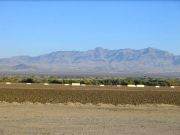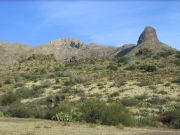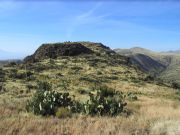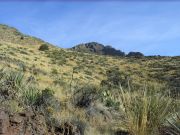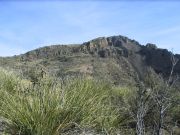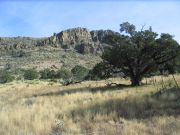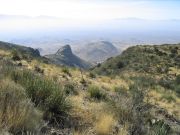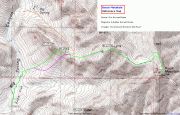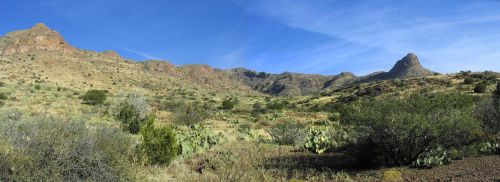
The Mountains of Arizona
• www.surgent.net
|
| Bryce Peak |
• Highpoint: Gila Mountains • San Carlos Indian Reservation • Graham County |
|
Date: November 22, 2008
• Elevation: 7,298 feet
• Prominence: 2,228 feet
• Distance: 6 miles
• Time: 7 hours and 20 minutes
• Gain: 2,500 feet
• Conditions: Pleasant fall weather
• Teammates: Scott Casterlin
Bryce Peak is the highest point of the Gila Mountains in Graham County. The Gila Mountains parallel the Gila River Valley north of the cities of Safford, Thatcher and Pima. The range itself features an assortment of rounded hilltops and spires, with cliff bands visible from town. The vertical differential between the Gila River and Bryce Peak's summit is nearly 5,000 vertical feet, but the range is set back so that the difference seems less to the eye. Given that nearby Mount Graham has nearly 7,000 feet of vertical differential relative to the Gila River basin, and is much closer to town, it's fair to say that Bryce Peak exists in the shadows, figuratively, of mighty Mount Graham.
Scott Casterlin of Tucson brought up Bryce Peak during our last trip on Turtle Mountain in September (the two peaks lie about 15 miles apart). We waited until November when we could count on cool and clear days, and arranged to meet in Safford. I left home Friday after school and arrived into Safford around 6 p.m., already dark, had a meal at the Golden Corral, then planned to "camp" at the nearby WalMart. I gave up on that idea quickly, realizing there were too many distractions, so I spent a couple bucks and camped at the Roper Lake State Park south of town. I met Scott at the WalMart around 6:30 a.m. the next morning. After piling my stuff into his vehicle, I left my truck at the WalMart and rode shotgun with Scott. The day started cold but was warming as the sun rose.
From Safford, we went west on US-70 to the town of Pima, north on Main Street a couple miles to the smaller town of Bryce, and then right onto Black Point Road, tucked in between residences and a culvert. Black Point Road leads into the range and to a few scattered ranches, evidenced by the big metal arch that spans over Black Point Road featuring the various ranch brands. We followed Black Point Road 6.7 miles north to a Y-junction, then right into the foothills for another 3.6 miles (10.3 miles in all) to a corral at Bobs Flat. It took us 45 minutes to drive to this point along mostly good, sometimes rocky road.
We parked at the corral, a sign on the fence mentioning the gate itself may be locked at any time. In the early morning, we could make out Bryce Peak , still in shadow, surrounded by cliffs on its south and west faces. A prominent canyon drops from the peak down to us. To our right is a large rock pinnacle called Point 6,047 (its elevation) on the map. Although we did not climb this way, Point 6,047 served as a visual gauge of our vertical progress throughout the day. At the moment it stood nearly 1,300 feet higher than us, with Bryce Peak another 1,200 feet above it. It was slightly after 8 a.m. when we started the hike. The day was still cool but sunny and cloudless.
The map shows a ridge west of the summit that seemed to have consistent spacing of contours, suggesting moderate gradients, so we chose to try from the west. We walked the ranch road north past the corral to a windmill and slightly past it, until we were a little more toward the west ridge itself. For reference purposes, the west ridge featured a rock pinnacle at roughly 5,940 feet elevation (we'll call it Point 5,940). To its east (our right) were smaller rocky pinnacles along the ridge, too small to appear on the map but large enough (twenty to forty feet in height) to be potential obstacles. Eyeballing the ridge showed many rocks and cliffs, but also open slopes and ways through the rocks, so we felt confident about our plan.
At some point we left the road, crossed a barbed-wire fence and started up the grassy and rocky slopes, dodging cactus along the way, steadily making upward progress up the ever-steepening slopes aiming for Point 5,940. Actually, we wanted to be slightly east of this line, but a large drainage blocked a traverse, so we had no choice but to climb up to the headwall of the drainage then cross laterally eastward.
This segment went rather slow and the grade was very steep, the terrain loose and each step taken carefully. We made our way across the headwall and then up a steep rocky section. We took this upper slope section slowly, aiming for another rock pinnacle at elevation 5,840 feet (hence its name for this narrative, Point 5,840). Finally we solved the rock and cliff maze and surmounted the ridge, actually climbing up and onto the top of Point 5,840 where we took an extended break. Point 5,940 stood higher to the west, and Bryce Peak still stood high to the east. It took 90 minutes to get here, slower than planned, but we had gained about 40% of our elevation and the going from here looked to be a lot less steep and sloppy.
The next destination was a prominent point at 6,778 feet ("Point 6,778"), located above us at the top of a gently-sloped ridge. From our perch on top of Point 5,840, we dropped about a hundred feet to a saddle at the base of this slope. For the climb up to Point 6,778, we made our own way up these slopes, the same mix of grass, cactus, thorny plants, agave and "submerged rocks", which you can't see through the grass mat but roll out from under you when you step on them. For most of this stretch our destination, Point 6,778, was invisible to us, so we took each little hump along the ridge one at a time. Higher up a few juniper trees dotted the hillside. Despite the cool temperatures, the sun was warm and the shade of the juniper was welcome during our breaks.
In time, we had covered most of the vertical distance toward Point 6,778, which now looked a lot bigger and menacing than it had from below, with the natural concern being how to get by that big pinnacle. It was here we (or more accurately Scott) came upon an unexpected but welcome surprise: a trail. Yes, an actual path that traversed east below Point 6,778 for about a quarter-mile. This trail led us onto a high saddle and meadow directly below Bryce Peak itself. The path petered out at a fence line.
We followed the fencing a few hundred more feet to a grouping of big alligator junipers where we took another break. This trail was a welcome surprise as it easily knocked off an hour of tedious sidehilling, and avoided the need to surmount the ridge near Point 6,778. In the meadow below Bryce, we could now see the remainder of our route. Despite being fronted by cliffs on its west, an obvious hiker's route could be seen by trending slightly north to a saddle up on a high ridge, then south to the summit.
Getting to the high saddle north of Bryce meant traversing across thick brush, but we managed to find a way that (mostly) avoided the thickest of the brush. At times we "sensed" a trail, but nothing substantial like the one previously. Even so, it stood to reason some earlier geologists/mappers/ranchers may have knocked in a path for their needs. We followed what we felt to be the path of least resistance, and gained this high saddle quickly. After another break we climbed the final 250 feet up and over one minorly steep section, then up gently-pitched slope to the summit. The top rocks sit precariously close to the edge of the south and west cliffs, and the views were outstanding.
We arrived on top at roughly 12:30 p.m. A quick scan of the sign-in logs shows how rarely this peak is climbed: the log, placed in 1991, had less than 10 entries, and often had three-to-four year stretches between signatures. Even if only half the summiters sign in, it still suggests a very-rarely visited peak. And wouldn't you know, we knew personally about 60% of those who had signed in.
We spent 30 minutes up top, trying to pick out nearby peaks and distant ranges. A big fire was spotted way to the north, somewhere on the White River Apache lands near Show Low. Turtle Peak was visible to the east, Mount Graham to the south, and a multitude of nameless peaks to the west and northwest. The broad Natanes Plateau was visible north and northwest of us, a big stretch of land managed by the San Carlos Reservation. Finally, shortly after 1 p.m., we shoved off for the descent.
I went ahead of Scott and made pretty good time to the high saddle, then from there back down to the meadow. We both felt pretty energetic so we kept moving, meeting up with the trail, traversing it, then making the methodical descent down the slopes to the low saddle at 5,820 feet, all this in less than an hour. This is where we broke from this morning's route and opted to drop into the northwestern canyon. The map shows a 600-foot descent to the road, from where we'd walk it back south a little over a mile, and 500 feet downward, to Scott's car.
At first, the descent went quickly but soon we were in the heart of this canyon. It took 45 minutes to downclimb it, a steady mix of brush, cactus and big rounded rocks. As canyons go it's fairly tame, but we were sure happy to see that road at the end. The final walk down to the car took 20 minutes and went well. We arrived back at Scott's vehicle at 3:30 p.m., a 7-hour, 20-minute round-trip hike. We took time here to relax, change into drier clothes, have some lunch and (for me) shoot some more photographs, before driving the road back out to Safford.
We arrived in Safford about 4:30 p.m. After transferring my stuff back to my truck at the WalMart, I decided to spend an extra night in town at the Essence of Tranquility hot springs. Scott and I got some Mexican food in town (two complete meals for less than $20!). I was back to the hot springs by 6:00 p.m. in the dark, but the dip into the hot water felt like heaven for my sore leg muscles. I slept like a log in my truck at the campground, and drove back to Chandler the following day.
I was happy to have hiked Bryce Peak, and pleased that it went well with minimal difficulties. Other than the endless loose rocks, the hike was a pleasure and a chance to hike in some hills that evidently see maybe only handful of people a year. Thanks as always to Scott from suggesting it, driving us in and keeping me from falling on my head.
|
|
